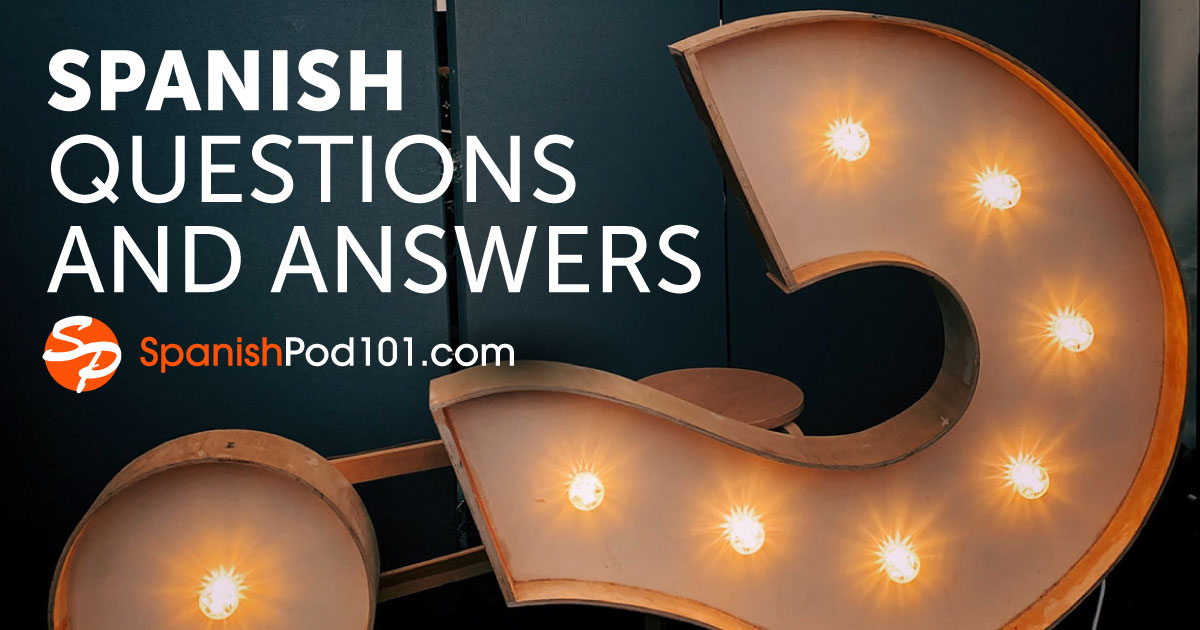
Can you ask questions in Spanish yet?
We’re sure you’re aware that to master any language, you can’t rely solely on affirmative sentences. You need to know how to ask questions, though some questions are more important than others. This is especially true for non-native speakers who are just starting out. Knowing the right questions can help you survive self-introductions, and others can get you out of sticky situations.
The first thing you need to learn, if you haven’t yet, are Spanish question words. Knowing these words, as well as the most common questions in Spanish, you can start asking your own questions! You can find a list of Spanish question words in our article about pronouns.
Now, onto our list of Spanish questions and answers for beginners!
 Table of Contents
Table of Contents
- ¿Cómo te llamas? – “What’s your name?”
- ¿De dónde eres? – “Where are you from?”
- ¿Hablas español? – “Do you speak Spanish?”
- ¿Cuánto tiempo llevas estudiando español? – “How long have you been studying Spanish?”
- ¿Alguna vez has estado en España? – “Have you ever been in Spain?”
- ¿Cómo es…? – “How is…?”
- ¿Te gusta la comida española? – “Do you like Spanish food?”
- ¿Qué estás haciendo? – “What are you doing?”
- ¿Qué te pasa? – “What’s wrong?”
- ¿Cuánto cuesta? – “How much is it?”
- How SpanishPod101.com Can Help You Master Spanish
1. ¿Cómo te llamas? – “What’s your name?”
Our first question is one that you’ve probably heard before. The literal translation of this question would be something like “How are you called?” But while that might sound weird, you probably realize that this is just the classic question we ask to learn someone’s name. This question is very important, and usually one of the first ones you learn when you start studying Spanish.

Other Ways of Asking this Question
There’s another way to ask the same question, though it’s not as popular as the one above:
¿Cuál es tu nombre?
This one doesn’t have a strange literal translation. Instead, it just means “Which is your name?” which makes it easier to explain, doesn’t it? Because it’s a near-literal translation of the English question, you might be tempted to use this one instead of ¿Cómo te llamas? But remember that the first one we showed you is more common, so you’ll sound more natural if you use that one.
How to Answer this Question
There are a few different ways of answering this question, and even though some are longer than others, they’re all equally valid. In this case, there’s no one answer that’s most common, except for maybe the last one, which is also the easiest. It’s your lucky day!
Example: Me llamo Francisco.
Translation: “My name is Francisco.”
Example: Soy Ana.
Translation: “I’m Ana.”
Example: Juan.
Translation: “Juan.”
Something else you might find useful is how to follow your answer after someone has asked you your name. You can add ¿Y tú? (“And you?”) at the end if you would also like to know their name.
If you’re curious about Spanish names, here’s an article from late 2018 that lists some common names in Spain.
2. ¿De dónde eres? – “Where are you from?”
Here’s another one of the most basic Spanish questions that we commonly use when meeting someone for the first time.
Other Ways of Asking this Question
There’s another common way of asking this question, which we use in English as well.
Example: ¿De dónde vienes?
Translation: “Where do you come from?”
How to Answer this Question
Once again, there are different, equally valid answers we can give to a question like this. You can refer to your nationality or to your home country.
Example: Soy húngaro.
Translation: “I am Hungarian.”
Example: Soy de Hungría.
Translation: “I am from Hungary.”
Example: Vengo de Hungría.
Translation: “I come from Hungary.”
3. ¿Hablas español? – “Do you speak Spanish?”
This is a question that you might be asked, or that you might ask, someday. Of course, you can change it to ask about any other language. For example, if you’re in Spain and you’re talking to someone in Spanish, but you’re not feeling too comfortable yet, you could ask them: ¿Hablas inglés? (“Do you speak English?”) and hope they say yes!
How to Answer this Question
There are a few different answers you could give someone who asks you this question.
There are the simple answers, which you probably already know:
Example: Sí.
Translation: “Yes.”
Example: No.
Translation: “No.”
There’s another simple alternative to “yes” or “no” in case you didn’t understand the question in the first place (which we could say is really another way of telling them you’re not too fluent yet):
Example: ¿Qué?
Translation: “What?”
And a few more elaborate answers:
Example: Un poco. / Un poquito.
Translation: “A bit.” / “A little bit.”
Example: Hablo [un poco] de español.
Translation: “I speak [a bit of] Spanish.”
4. ¿Cuánto tiempo llevas estudiando español? – “How long have you been studying Spanish?”
When you meet someone from Spain and tell them you study Spanish, they might ask how long you’ve been doing that for.
How to Answer this Question
The answer you give (or that you’re given) will obviously vary, but you have two simple options. One is to just say the short answer:
Example: Un año.
Translation: “One year.”
While this will work just fine, we do have a slightly longer (no panicking, it’s just one extra word!) reply:
Example: Llevo tres meses.
Translation: “[I have been] for three months.”

Notice that both the question and the “long” answer use the verb llevar. This verb usually means “to bring,” but it’s also used to talk about the amount of time you’ve been doing something for. Another example using this verb would be: Llevo dos años viviendo en Barcelona. (“I’ve been living in Barcelona for two years.”)
5. ¿Alguna vez has estado en España? – “Have you ever been in Spain?”
Following are some useful questions and answers for Spanish-learners who are traveling to a Spanish-speaking country or chatting with someone who’s familiar with Spain.
Other Ways of Asking this Question
Example: ¿Has ido alguna vez a España?
Translation: “Have you ever gone to Spain?”
Example: ¿Has estado en España?
Translation: “Have you been in Spain?”
Example: ¿Alguna vez has visitado España?
Translation: “Have you ever visited Spain?”
Or, a slight variation:
Example: ¿Es la primera vez que vienes a España?
Translation: “Is this the first time you’ve come to Spain?”
How to Answer this Question
This is another yes-or-no question, so we have a couple of obvious answers. However, there are a few more options, including longer answers, that you might like to use if you’re feeling confident enough.
Example: No, nunca he estado.
Translation: “No, I’ve never been there.”
Example: He estado en España dos veces.
Translation: “I’ve been in Spain twice.”

6. ¿Cómo es…? – “How is…?”
This is a more open-ended question that you can alter based on your inquiry; it’s used to ask someone to describe something. In English, the translation will sometimes be something more like: “What’s ___ like?” Here are some examples:
Example: ¿Cómo es Granada en invierno?
Translation: “How is Granada in the winter?”
Example: ¿Cómo es el interior de una pelota?
Translation: “What is the inside of a ball like?”
How to Answer this Question
Because there are so many different questions one could ask, there are even more answers one could give. An example would be to use an adjective, but other times, the question might require a longer explanation.
Example: ¡Es maravilloso!
Translation: “It’s wonderful!”
7. ¿Te gusta la comida española? – “Do you like Spanish food?”
Spaniards are very, very proud of their cuisine. That means that if you’re visiting Spain (or have visited in the past), and you meet someone Spanish, it’s quite likely that they’ll ask you this. In case you’re wondering, they’re expecting you to tell them you love it.
Other Ways of Asking this Question
Here’s another common way to ask this question:
Example: ¿Qué te parece la comida española?
Translation: “What do you think about Spanish food?”

How to Answer this Question
Example: ¡Me encanta!
Translation: “I love it!”
Example: Me gusta mucho.
Translation: “I like it very much.”
We hope you never use it to answer this question, but we thought we should probably teach you how to say you don’t like it.
Example: No me gusta [nada].
Translation: “I don’t like it [at all].”
8. ¿Qué estás haciendo? – “What are you doing?”
This question is pretty clear, we think! It can be asked in different contexts and with different intentions, but in any case, we understand it.
Other Ways of Asking this Question
We have another similar way of asking this question:
Example: ¿Qué haces?
Translation: “What do you do?”
This is the literal translation, but it may also refer to what one is doing at the moment of asking the question.
How to Answer this Question
Obviously, there are many ways of answering this question, because there are many things you could be doing.
Example: Estoy limpiando mi habitación.
Translation: “I’m cleaning up my room.”
We don’t want to say anything, but in case you ever need it, we thought we’d give you the following example:
Example: No es lo que parece.
Translation: “It’s not what it looks like.”
9. ¿Qué te pasa? – “What’s wrong?”
Sometimes you might feel like someone is down or struggling. You need to know the right question to ask in order to help them out.
Other Ways of Asking this Question
While this version of the question doesn’t have exactly the same meaning, you could still ask it in a similar situation:
Example: ¿Estás bien?
Translation: “Are you okay?”
How to Answer this Question
You never know what reply you’re going to get, but there are a few answers you’re likely to hear. It’s also possible that the person you ask won’t want to give you a direct answer:
Example: Nada.
Translation: “Nothing.”
Or maybe they’ll reply with an adjective, by telling you an emotion they’re feeling.
Example: Estoy enfadado/a.
Translation: “I’m angry.”
Example: Estoy triste.
Translation: “I’m sad.”

Perhaps they’ll really explain the reason something’s wrong:
Example: Mi hermana está muy enferma.
Translation: “My sister is very sick.”
10. ¿Cuánto cuesta? – “How much is it?”
If you want to go shopping in a Spanish-speaking country, but you can’t find the price tag, it will be useful to know these simple Spanish questions and answers.
Other Ways of Asking this Question
Example: ¿Cuánto es?
Translation: “How much is it?”
How to Answer this Question
Example: Cuesta 400 €.
Translation: “It costs 400 €.”
Example: Son 3 €.
Translation: “It’s 3 €.”

11. How SpanishPod101.com Can Help You Master Spanish
We hope you found these common Spanish questions and answers useful, and that they inspire you to ask more questions and learn more in order to become fluent in Spanish.
Are there any questions we missed? Let us know in the comments, and we’ll do our best to help you out!
Remember there’s a lot more that you can learn at SpanishPod101.com. Check out our great variety of lessons, our free vocabulary lists, and much more.










